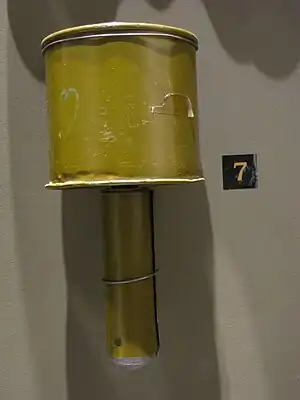| RPG-40 | |
|---|---|
 Soviet RPG-40 anti-tank grenade | |
| Type | Anti-tank grenade |
| Place of origin | Soviet Union |
| Service history | |
| In service | 1940 |
| Used by | Soviet Union and Warsaw pact countries |
| Wars | World War II |
| Production history | |
| Designer | M. I. Puzirev[1] |
| Designed | 1938[1] |
| Specifications | |
| Mass | 1.2 kilograms (2.6 lb)[1] |
| Length | 20 centimetres (7.9 in) |
| Filling | TNT |
| Filling weight | 0.760 kilograms (1.68 lb)[1] |
The RPG-40 was an anti-tank hand grenade developed by the Soviet Union in 1940.[1]
Description
Upon contact, 760 grams (1.68 lb) of explosives contained within it were detonated and produced a blast effect. This enabled about 20–25 millimetres (0.79–0.98 in) of armour to be penetrated and caused secondary damage, such as spalling, on contact with thicker armour.[1] This made the grenade very effective against earlier German tanks, but ineffective against later models, such as the Panzer IV and the Panzer V, leading to the RPG-43 replacing it in 1943.
Users
See also
References
External links
This article is issued from Wikipedia. The text is licensed under Creative Commons - Attribution - Sharealike. Additional terms may apply for the media files.